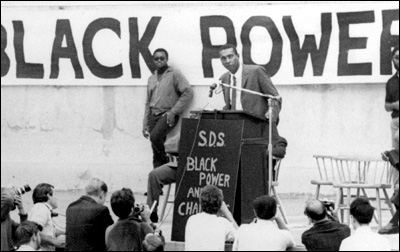 | |
| Dr. Martin Luther King, Jr. and Stokely Carmichael in 1966. Source |
In this week’s readings, we discussed the concept of team
leadership and how effective they can be when done correctly. In our group
discussions, I spoke about the Student Nonviolent
Coordinating Committee (SNCC) and their take on leadership. Before
globalization and networking were the buzzwords that they are today, the group
utilized them in the manner that Western
defines eco-leadership. According to Western (2013), eco-leadership focuses on
a network of leaders as opposed to one centralized figure. The group functioned
differently from some organizations and instead of utilizing top down methods,
utilized a committee to achieve their goals. From their initial committee of
protest group representatives, they formed an Executive Committee to help move
the group forward. One member of this group was Stokely
Carmichael.
Carmichael was a master networker. In the hyperlink above,
NPR refers to him as having “his hand in every major demonstration and event
that occurs between 1960-1965” (Para. 2). In a time where social media is
nonexistent, to be among those who cast long shadows, especially at his age, is
impressive. He is well known for being a charismatic and transformational
leader. In fact, in an obituary penned by the New York Times, one man was
quoted as saying that “watching
him made him believe that the young man could ‘stroll through Dixie in broad
daylight using the Confederate flag for a handkerchief.’” So how does Carmichael
relate to the idea of team leadership?
 |
| Carmichael at the University of California in 1966. Source |
Ideally, Northouse
(2016) states that “for teams to be successful, the organizational culture
needs to support member involvement” (p. 364). SNCC most certainly made efforts
to include and educate members of the public, epitomized in the figure of the
young Carmichael. Northouse (2016) further states that taking on shared
leadership does have its risks, especially for the member who provides
leadership outside of the team. Carmichael became the chairman of SNCC in 1966,
but soon irritated his cohort as he achieved celebrity status, earning him the
nickname “Stokely Starmichael”. Eventually, because his ideas became too
radical for his team members (he popularized the slogan “Black Power” and
became more revolutionary), he was expelled from SNCC.
In his reflections, Carmichael thought that his expulsion “revealed SNCC’s
‘struggle between reformers and revolutionaries.’” According to Western
(2013), eco-leadership is often divided between the two: reformers are
typically politicians and organizational leaders who “advocate responsible or caring capitalism” while radicals are activists who believe “that
reform merely prolongs a dying system” (p. 266). Carmichael died of cancer in
1998 and, despite his fractured connection with SNCC, their relationship frames
eco-leadership, both strengths and weaknesses, almost perfectly.
No comments:
Post a Comment